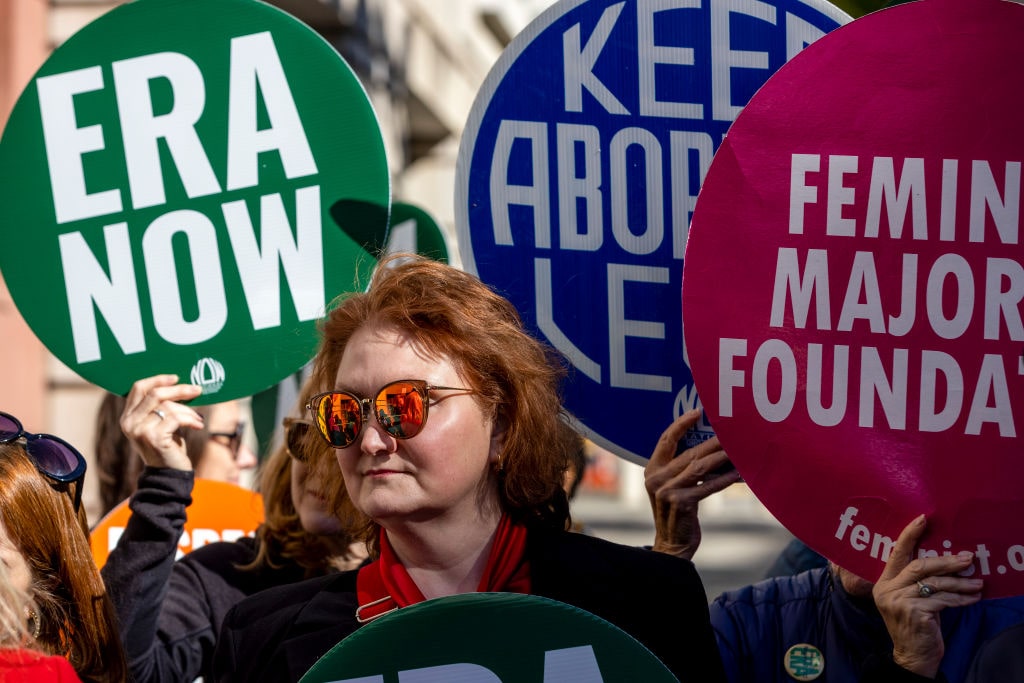The Equal Rights Amendment has been removed as a ballot initiative for the November elections in New York. The proposed change to the state’s constitution easily and quickly passed through the legislature in response to the Supreme Court’s Dobbs v. Jackson’s Women’s Health Organization ruling that overturned Roe v. Wade. And the many progressive voters of the Empire State no doubt looked forward to enshrining it in their constitution just as decisively. But according to the judge who struck it down, the speed with which the amendment was approved is the problem. The process was rushed, making the ballot initiative unconstitutional.
“They put forth this amendment to the constitution. There was no open debate. There was no public hearings, there was nothing,” explained Bobbie Anne Cox, the attorney who sued the legislature to stop the referendum. “They referred it to the AG that day, but then they voted that same day. They didn’t even wait one day,” Cox added.
 The New York Constitution requires that a proposed amendment must be presented to the attorney general to determine that it isn’t in conflict with other parts of the constitution, and the AG has 20 days to respond. New York Supreme Court Justice Daniel J. Doyle declared the amendment null and void because the Democrats didn’t give the attorney general the required time – or, really, any time at all.
The New York Constitution requires that a proposed amendment must be presented to the attorney general to determine that it isn’t in conflict with other parts of the constitution, and the AG has 20 days to respond. New York Supreme Court Justice Daniel J. Doyle declared the amendment null and void because the Democrats didn’t give the attorney general the required time – or, really, any time at all.
Equal Rights or Progressive Ideology?
Opponents and supporters alike recognize that this Equal Rights Amendment would enshrine in the New York Constitution a legal right to abort. Indeed, many would argue it’s the whole point of the amendment. But that isn’t all that has conservatives concerned about this ERA. Some fear it threatens parental rights, as it would guarantee “gender-affirming” care for kids, including gender reassignment surgery or puberty blockers, without need for parental consent. Some also argued that it would require sports programs to allow biological males who identify as female to compete against girls and women. “Any decent lawyer will take one look at the Proposition One language and say, ‘You’ve got to be kidding me,’” said Greg Garvey, the executive director of the Coalition to Protect Kids – New York. “This ballot initiative is written so broadly and so poorly that it could cause irreparable harm to children and families,” he continued.
The amendment would have modified the New York State Constitution Article 1, Section 11. The text of the proposed amendment reads:
“1. No person shall be denied the equal protection of the laws of this state or any subdivision thereof. No person shall, because of race, color, ethnicity, national origin, age, disability creed, or religion, or sex, including sexual orientation, gender identity, gender expression, pregnancy, pregnancy outcomes, and reproductive healthcare and autonomy, be subjected to any discrimination in their civil rights by any other person or by any firm, corporation, or institution, or by the state or any agency or subdivision of the state pursuant to law.
“2. Nothing in this section shall invalidate or prevent the adoption of any law, regulation, program, or practice that is designed to prevent or dismantle discrimination on the basis of a characteristic listed in this section, nor shall any characteristic listed in this section be interpreted to interfere with, limit, or deny the civil rights of any person based upon any other characteristic identified in this section.”
What makes this stand out from the usual talk of equal rights, which classically evokes the civil rights movements against racism and sexism, is the addition of “gender identity, gender expression, pregnancy, pregnancy outcomes, and reproductive healthcare and autonomy” to the list of classes protected from discrimination.
What’s in a Name?
The New York State Bar Association published an article in March titled “What the Equal Rights Amendment Will Mean in New York,” written by Kimberly Wolf Price. The article, which clearly endorses this ERA, makes the point that 29 states have some sort of equal rights amendment in their constitutions but that New York doesn’t.
 “This means that judicial review of any alleged discrimination under the categories of gender, gender identity, sex, age, disability, et al. is based on intermediate scrutiny, a lower standard than that provided to constitutional protections,” Price wrote. “And while laws can be altered each legislative session, any amendment to New York’s Constitution must follow the constitutionally mandated complicated path the ERA has traveled to the ballot.” Notice how Price didn’t mention the abortion protection in that statement, choosing rather to include it in the “et al.” bit?
“This means that judicial review of any alleged discrimination under the categories of gender, gender identity, sex, age, disability, et al. is based on intermediate scrutiny, a lower standard than that provided to constitutional protections,” Price wrote. “And while laws can be altered each legislative session, any amendment to New York’s Constitution must follow the constitutionally mandated complicated path the ERA has traveled to the ballot.” Notice how Price didn’t mention the abortion protection in that statement, choosing rather to include it in the “et al.” bit?
What the author of this article and the NY Bar Association – or, for that matter, most LGBTQ or abortion advocates – don’t highlight is that not all equal rights amendments are created equal.
“False equivalence is a logical fallacy that occurs when someone incorrectly asserts that two or more things are equivalent, simply because they share some characteristics, despite the fact that there are also notable differences between them,” wrote Dr. Itamar Shatz of the University of Cambridge Department of Theoretical and Applied Linguistics. The simple example he gave after that explanation paints a good picture: “For example, a false equivalence is saying that cats and dogs are the same animal, since they’re both mammals and have a tail.”
Sometimes, however, one must dig a little deeper to find the false equivalence. In this case, the shared characteristic is the name. Many states have equal rights amendments, but how many match the wording of what Empire State progressives hoped to add to the New York Constitution?
Florida’s 1998 amendment reads:
“All natural persons, female and male alike, are equal before the law and have inalienable rights, among which are the right to enjoy and defend life and liberty, to pursue happiness, to be rewarded for industry, and to acquire, possess and protect property. No person shall be deprived of any right because of race, religion, national origin, or physical disability.”
“Equality under the law shall not be denied or abridged because of sex, race, color, creed, or national origin. This amendment is self-operative,” reads the 1972 ERA of Texas. Montana has, since 1973, protected people from discrimination based on “race, color, sex, culture, social origin or condition, or political or religious ideas.”
Notice how none of these equal rights amendments constitutionally protect abortion or declare it a crime to insist there are only two genders? These cats and dogs may all be mammals, but they’re far from the same animal.




